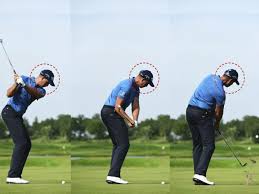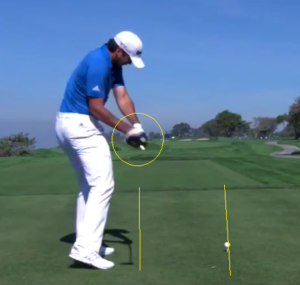It may have been Michael Breed (on the Golf Channel) that came up with this line and he was so right. If you have a consistent drive, your approach shot is the most critical shot for every hole. You are faced with a 100 to 180 yard shot into the green on a par 5, 4 or 3. If you can land that shot on the green and 2-putt every green, this game is easy.
The 2017 September issue of Golf Digest gave us some great tips to hit more greens in regulation. Consistency, Distance and Direction are all critical issues.
Consistent Waist Bend for Consistent Contact:
If you keep the same bend at your waist throughout your swing, the distance from your neck to your ball will remain the same in your setup and at impact. Rotate your shoulders around your spine during your swing without bobbing up and down during your back and down swing. Lunging down at the ball during your downswing WILL create mishits.
High handicap golfers average a 25 degree angle across their shoulders (pointing down toward the ball) at the top of their backswing. The shoulder slant for Pros is about 35 degrees because they don’t straighten up during their backswing. They simply rotate around their spine by coiling and uncoiling.
Distance:
Know Your Club Distances: Every golfer has to learn the distance that they hit every club. Wind and elevation changes will impact the distance for every hit and it is up to you to account for the impact. Jack Nicklaus reminds us to use the average distance (not your best distance) that you expect for each club. Swing at 85% and don’t expect the “hero shot” with every club.

In this Golf Digest front cover showing Brooks Koepka you can see his weak leading hand grip and strong trailing hand grip. It may not work for you but it sure helps him bow his wrist for direction control.
Direction:
Every professional golfer has their own routine to control the direction of their irons. Swinging a golf club in a circle makes it almost impossible to control the precise direction for every shot. Brooks Koepka is definitely a long ball hitter but his direction control with irons is critical for his success. He uses these swing thoughts for his iron shots:
–Weak grip for his left hand (thumb V points up to his neck) and strong grip for his right hand
–Lineup with an open stance to create a fade. He finds it’s easier to control direction.
–Straight leading arm for a wide and high backswing to generate distance.
–A slightly bowed left wrist in his backswing helps him line up the direction of his impact.
–Hip bump toward the target to start his weight transfer during his transition.
–Good body rotation in the back swing and follow-through.
–Sidearm release of his trailing hand through impact for more power in his release. [I use some of these pointers, especially the straight arm, straight back swing with a slight loop at the top as I bump my hip and release from the inside as my trailing elbow grazes my side. These key swing movements have improved the consistency of my drives to 95% and length by 20 to 40 yards. ]
Your strength in each arm and leg will affect the way you swing your clubs. Brooke Koepka is just an example from one professional to consider when you are trying to improve your direction control to hit more greens in regulation. Sort out your direction control at the range or with a PGA Professional and practice with GOLFSTR+ for every swing in your game. Buy one today at www.golfstr.com




